The Army Combat Fitness Test (ACFT) has become the new standard for assessing the physical readiness of soldiers in the United States Army. With its emphasis on functional fitness, the ACFT includes a variety of events that test different aspects of strength, endurance, and agility.
For many soldiers, preparing for the ACFT involves a combination of gym sessions, outdoor training, and specialized equipment. However, with the rise of home-based fitness trends and the constraints of busy schedules, the question arises: Is it possible to prepare for ACFT events at home?
Understanding the ACFT Events:
Before delving into the feasibility of preparing for ACFT events at home, it’s crucial to understand the key components of the test. The ACFT comprises six events: the three-repetition maximum deadlift, standing power throw, hand-release push-ups, sprint-drag-carry, leg tuck, and a two-mile run. Each event targets different muscle groups and fitness attributes, necessitating a well-rounded training approach [1].
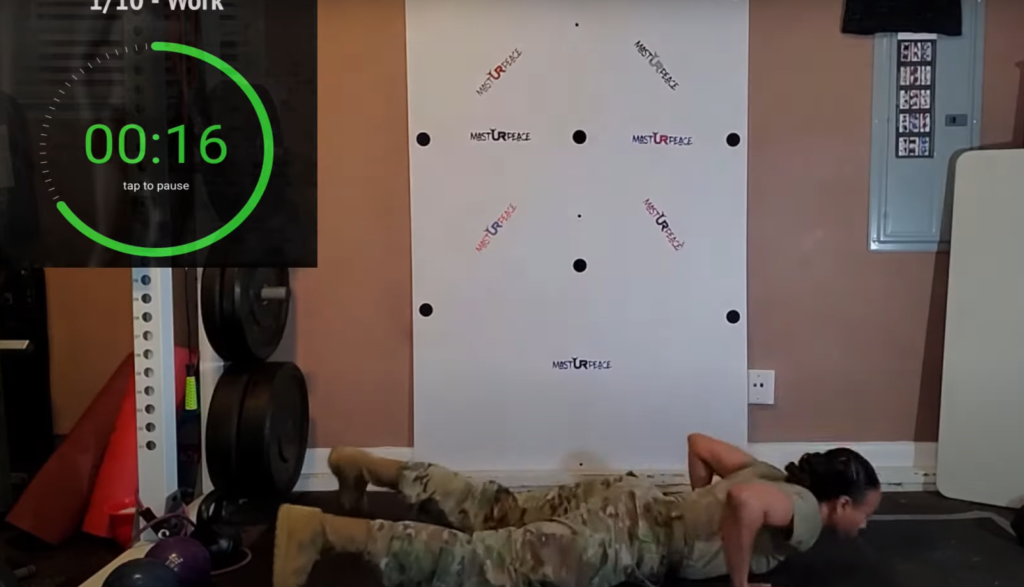
Three-Repetition Maximum Deadlift:
The deadlift event focuses on assessing the lower back, glutes, and hamstring strength. Performing deadlifts at home requires a sturdy barbell and weight plates, which may be a challenge for those without access to such equipment. However, alternative exercises like bodyweight squats, lunges, and single-leg Romanian deadlifts can help target similar muscle groups.
Standing Power Throw:
The standing power throw evaluates explosive power and upper body strength. While replicating this event exactly at home may be difficult, exercises like medicine ball throws against a wall, kettlebell swings, and explosive push-ups can contribute to developing the necessary strength and power.
Hand-Release Push-Ups:
Hand-release push-ups assess upper body endurance and muscular strength. This event is more easily replicable at home, as traditional push-ups and variations like decline push-ups can effectively target the chest, triceps, and shoulders.
Sprint-Drag-Carry:
This event combines elements of speed, agility, and strength. Simulating the sprint-drag-carry at home may be challenging due to space constraints, but high-intensity interval training (HIIT) sessions, including exercises like shuttle runs, burpees, and lateral shuffles, can help enhance cardiovascular endurance and agility.
Leg Tuck (Plank):
The leg tuck evaluates core and upper body strength. Performing leg tucks at home without specialized equipment might be challenging, but alternatives such as hanging leg raises, planks, and mountain climbers can be effective in building the required muscle groups.
Two-Mile Run:
The final event, the two-mile run, assesses cardiovascular endurance and overall running ability. Running is one of the most accessible exercises to do at home or in the neighborhood. Incorporating regular running sessions, either outdoors or on a treadmill, can significantly contribute to improving running performance.
Is It Possible To Prepare For ACFT Events At Home?
While the official ACFT requires specific equipment for some events, many effective training adaptations can be done at home with minimal or no equipment. Here’s a breakdown:
Possible at home:
- Three Repetition Maximum Deadlift (MDL): Use heavy objects like water jugs, backpacks filled with books, or sandbags. Focus on proper form and gradually increase weight;
- Hand-Release Push-Up (HRP): Utilize furniture like stairs, desks, or benches for incline or decline push-ups. Add backpacks or weights for more difficulty;
- Static Plank Hold (PLK): No equipment needed! Focus on proper form and gradually increase hold time;
- Two-Mile Run (2MR): Find a safe route near your home, track your distance and time, and practice incorporating interval training for speed and endurance [2];
Adaptable at home with modifications:
- Standing Power Throw (SPT): Use medicine balls (filled with water, sand, etc.) or weighted objects for rotational throws. You can also mimic the movement with bodyweight exercises like squat throws or medicine ball slams;
- Sprint-Drag-Carry (SDC): This requires more creativity. Simulate the dragging motion with weighted sleds made from household items, sandbags, or furniture. Use weights or heavy objects for the carrying portion. Alternatively, practice shuttle runs with sprints and bodyweight squats or lunges;
Additional Tips:
- Focus on compound exercises: These work multiple muscle groups simultaneously, mimicking the demands of the ACFT. Examples include squats, lunges, burpees, and jump squats;
- Incorporate bodyweight exercises: Push-ups, planks, lunges, dips, and squats are excellent home workout staples;
- Utilize online resources: Many websites and apps offer ACFT-specific home workout routines and modifications;
- Listen to your body: Start slow, gradually increase intensity, and prioritize proper form to avoid injury;
- Consider alternatives: If you lack space or equipment, explore bodyweight-only routines or find outdoor alternatives like running hills or stairs;
Remember, consistency is key. By diligently training at home with smart adaptations, you can effectively prepare for your ACFT, even without access to a gym.
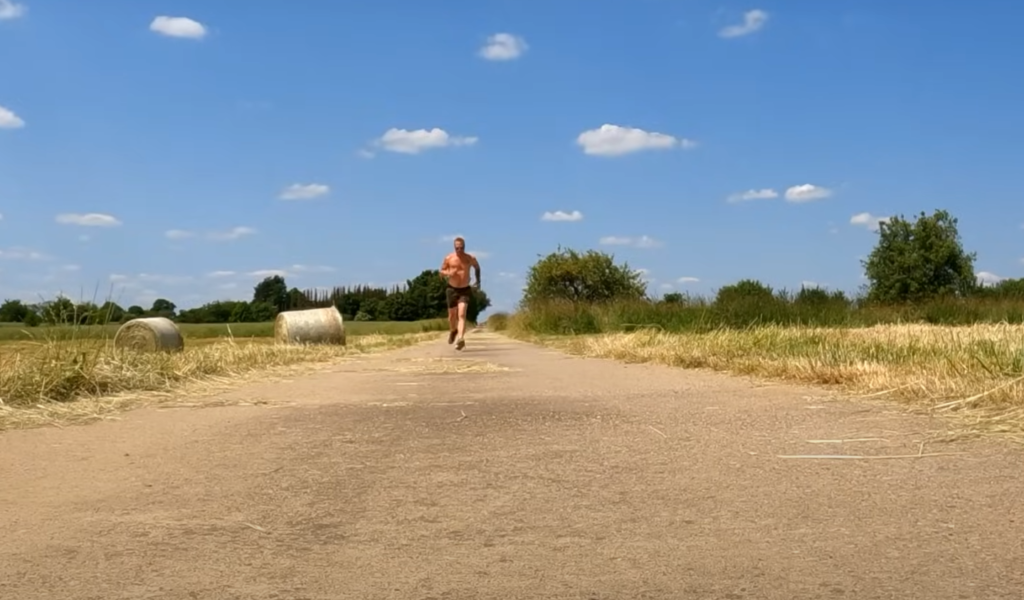
Prepare For the ACFT with 3 Essential At-Home Training Tools:
1. Kettlebells:
Versatility in Strength and Power Training:
[tds_note]Kettlebells are a powerhouse of versatility, making them an excellent addition to your at-home ACFT preparation arsenal. They offer a unique design that allows for dynamic movements, engaging multiple muscle groups simultaneously. The off-center weight distribution of kettlebells challenges stability, enhancing core strength – a crucial component of various ACFT events.[/tds_note]
Effective Kettlebell Exercises for ACFT Preparation:
- Kettlebell Swings: Targeting the posterior chain, kettlebell swings mimic the explosive hip hinge motion required for the deadlift event;
- Turkish Get-Ups: Promoting full-body stability and strength, Turkish get-ups contribute to overall functional fitness;
- Kettlebell Snatches: Enhancing power and coordination, snatches mimic the explosive movement required for the standing power throw;
At-Home Advantage:
Kettlebells are compact and require minimal space, making them ideal for home workouts. Whether you have a dedicated home gym or a small living room, kettlebells can easily fit into your at-home training routine, providing a challenging workout experience.
2. Medicine Balls:
Dynamic Power and Explosiveness:
Medicine balls are excellent tools for developing explosive power, a crucial element in ACFT events like the standing power throw and the sprint-drag-carry. The ability to throw, catch, and slam a medicine ball engages the entire body, emphasizing power production and coordination.
Effective Medicine Ball Exercises for ACFT Preparation:
- Overhead Throws: Enhance explosive power, mimicking the motion of the standing power throw event;
- Medicine Ball Slams: Develop power and engage the core, contributing to overall strength and endurance;
- Rotational Throws: Improve agility and rotational power, beneficial for events like the sprint-drag-carry;
At-Home Advantage:
Medicine balls are compact, require minimal storage space, and can be used indoors or outdoors. Their versatility makes them a convenient tool for at-home ACFT training, providing an effective means of targeting power and explosiveness.
3. Trap Bar:
Deadlift Mastery and Lower Body Strength:
The trap bar, also known as a hex bar, is a valuable tool for mastering the deadlift event in the ACFT. Its unique design allows for a more natural lifting position, reducing stress on the lower back. Incorporating the trap bar into your at-home training routine can significantly improve lower body strength and overall deadlift performance [3].
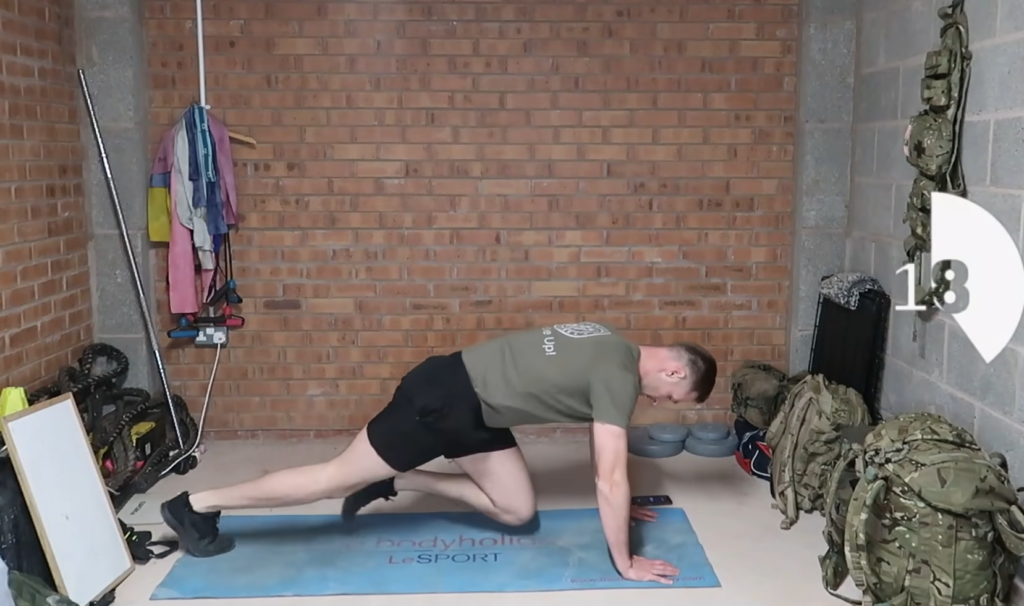
Effective Trap Bar Exercises for ACFT Preparation:
- Trap Bar Deadlifts: Targeting the same muscle groups as the ACFT deadlift event, trap bar deadlifts build strength and enhance lifting mechanics;
- Farmer’s Walks: Improve grip strength and simulate the carrying component of the sprint-drag-carry event;
At-Home Advantage:
While the trap bar may be bulkier than kettlebells and medicine balls, it remains a practical addition to a home gym setup. If space allows, the trap bar can serve as a centerpiece for lower body strength training, ensuring you’re well-prepared for the ACFT’s deadlift component.
How To Perform An ACFT Workout Plan Without Equipment:
1. Sprints:
Instructions:
- Find an open space, whether it’s a backyard, park, or even a long hallway;
- Perform 30-second sprints, followed by 30 seconds of rest or a slow jog;
- Repeat for 10-15 minutes to simulate the intensity of the sprint-drag-carry event;
Benefits:
Sprints enhance cardiovascular endurance, agility, and explosive power, crucial for ACFT events like the sprint-drag-carry and the two-mile run.
2. Bulgarian Split Squat:
Instructions:
- Stand with one foot forward and the other foot extended behind you on an elevated surface;
- Lower your body into a lunge position, keeping the front knee directly above the ankle;
- Perform 3 sets of 12-15 repetitions on each leg;
Benefits:
Bulgarian split squats target the lower body muscles, improving strength and stability similar to the demands of the sprint-drag-carry event.
3. Standing Power Throw:
Instructions:
- Use a medicine ball or any weighted object;
- Mimic the standing power throw motion by explosively throwing the object overhead;
- Perform 3 sets of 10-12 throws;
Benefits:
This exercise enhances upper body power, critical for the standing power throw event in the ACFT.
4. Squat Jumps / Box Jumps:
Instructions:
- Start with a squat position and explode into a jump;
- If possible, land on an elevated surface for box jumps;
- Perform 3 sets of 15-20 repetitions;
Benefits:
Squat jumps and box jumps target explosive lower body power, beneficial for various ACFT events, including the sprint-drag-carry.

5. Push-Ups:
Instructions:
- Assume a plank position with hands shoulder-width apart;
- Lower your body to the ground and push back up;
- Perform 3 sets of 15-20 repetitions;
Benefits:
Push-ups strengthen the chest, shoulders, and triceps, preparing you for the hand-release push-ups in the ACFT.
6. Sprint-Drag-Carry (Modified):
Instructions:
- Simulate the sprint-drag-carry by combining short sprints, dragging movements (e.g., pulling a heavy object), and carrying exercises;
- Perform each component for 1 minute, rest for 1 minute, and repeat for 3 rounds;
Benefits:
This modified version replicates the intensity and variety of movements in the actual ACFT event.
7. Leg Tucks / Planks:
Instructions:
- For leg tucks, hang from a sturdy bar and lift your knees toward your chest;
- For planks, maintain a plank position for 1-2 minutes;
- Perform 3 sets of 12-15 leg tucks or hold planks;
Benefits:
Leg tucks and planks strengthen the core, essential for the ACFT leg tuck event.
8. Pullups:
Instructions:
- Find a sturdy horizontal bar;
- Perform pull-ups, aiming for 3 sets of 8-10 repetitions;
Benefits:
Pull-ups target the upper body, particularly the back and arms, contributing to overall upper body strength for ACFT events.
9. 2-Mile Run (Modified):
Instructions:
- If possible, run outdoors or simulate the run on a treadmill;
- Perform 2 sets of 1 mile each, aiming for a pace consistent with your ACFT target time;
Benefits:
Running remains a fundamental aspect of the ACFT, and this modified version allows you to replicate the two-mile run.
Beginner ACFT Workout Plan For A Week:
Monday – Strength and Core Focus:
Deadlifts:
- Perform 3 sets of 8-10 repetitions;
- Focus on maintaining proper form and gradually increase weight as you progress;
Hand Release Push-Ups:
- Complete 3 sets of 12-15 repetitions;
- Ensure a full range of motion by releasing your hands from the ground at the bottom of each push-up;
Plank:
- Hold a plank position for 1-2 minutes;
- Engage your core and maintain a straight line from head to heels;
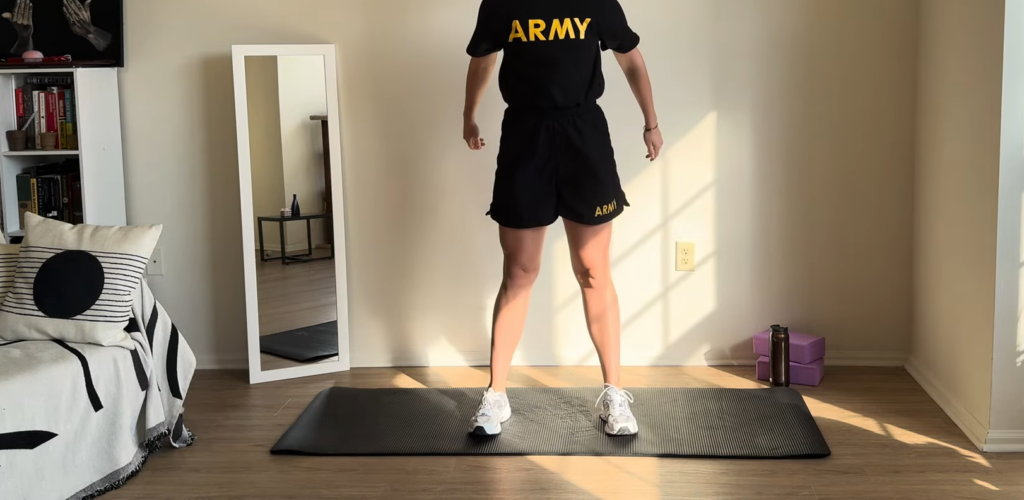
Tuesday – Explosive Power and Cardio:
Medicine Ball Throws:
- Perform 3 sets of 10-12 explosive throws;
- Use a moderate-weight medicine ball, focusing on power and coordination [4];
Shuttle Sprint Repeats:
- Set up a 20-meter distance and perform shuttle sprints;
- Complete 8-10 rounds with short rest intervals;
2-Mile Run (800m Repeats):
- Run 800 meters at a moderate pace, followed by a 1-minute rest;
- Repeat for a total of 4 sets;
Wednesday – Strength and Core Focus :
Repeat Monday’s Workout.
Thursday – Cardiovascular Endurance and Functional Fitness:
Medicine Ball Throws:
Perform 3 sets of 10-12 explosive throws.
Sprint-Drag-Carry (Modified):
- Simulate the sprint-drag-carry with short sprints, dragging movements, and carrying exercises;
- Perform each component for 1 minute, rest for 1 minute, and repeat for 3 rounds;
2-Mile Run (1-Mile Repeats):
- Run 1 mile at a moderate pace, followed by a 2-minute rest;
- Repeat for a total of 2 sets;
Friday – Strength and Core Focus:
Repeat Monday’s Workout.
Tips for the Week:
Progression:
- Start with weights and intensities that challenge you without compromising form;
- Gradually increase the difficulty as your strength and endurance improve;
Rest and Recovery:
- Ensure adequate rest between sets and exercises;
- Include a proper cool-down and stretching routine after each workout;
Hydration and Nutrition:
- Stay hydrated throughout the week, especially during and after workouts;
- Consume a balanced diet with an emphasis on lean proteins, whole grains, and fruits and vegetables;
Listen to Your Body:
- Pay attention to how your body responds to the workouts;
- If you experience persistent pain or discomfort, consider adjusting the intensity or seeking guidance from a fitness professional;
This beginner ACFT workout plan provides a balanced mix of strength, cardio, and functional fitness exercises throughout the week. Remember to tailor the plan to your fitness level, and gradually increase the intensity as you become more comfortable with the exercises.
[tds_council]Consistency and dedication are key to building the necessary strength and endurance for success in the Army Combat Fitness Test.[/tds_council]
Effective ACFT Training on a Budget: Techniques, Equipment And Tips
1. Standing Power Throw (SPT):
Technique:
- Focus on explosive hip and shoulder rotation;
- Engage your core and use your entire body to generate power;
- Practice with a variety of weighted objects, even homemade alternatives like sandbags;
Budget-Friendly Equipment:
- Use a sturdy backpack filled with books or sand as an improvised weight;
- Utilize a basketball or volleyball for throwing practice;
Tips:
- Incorporate full-body plyometric exercises like jump squats to improve explosive power;
- Practice the throwing motion with different objects to adapt to varying weights;
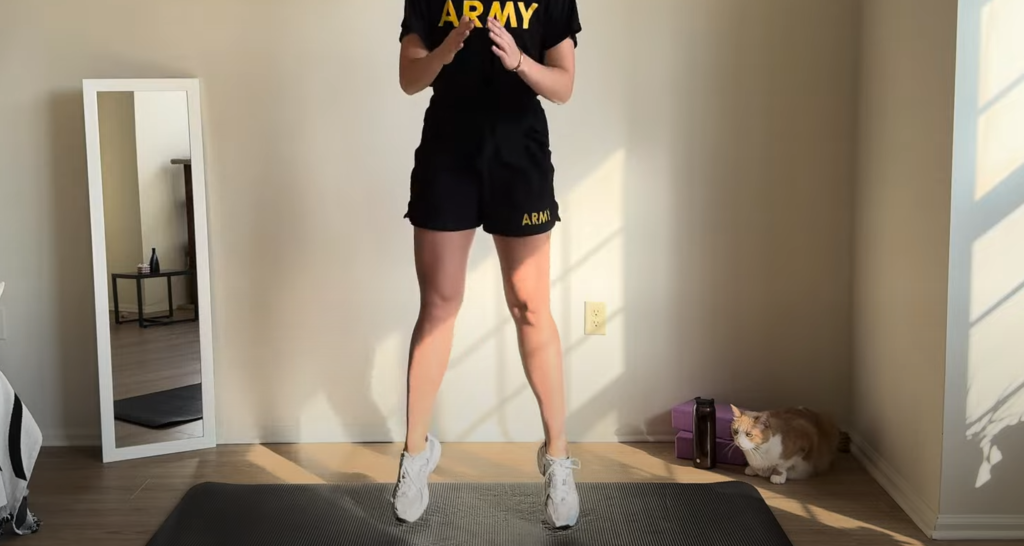
2. Hand-Release Push-Ups (HRP):
Technique:
- Maintain a straight line from head to heels;
- Fully release your hands at the bottom of each push-up;
- Focus on controlled, consistent movements;
Budget-Friendly Equipment:
- No additional equipment is necessary for hand-release push-ups.
Tips:
- Perform push-ups on a mat or carpet to alleviate discomfort on your hands;
- Focus on proper form and gradually increase the number of repetitions;
3. Sprint-Drag-Carry (SDC):
Technique:
- Emphasize quick transitions between sprinting, dragging, and carrying;
- Maintain an efficient and controlled form during each component;
Budget-Friendly Equipment:
- Substitute a heavy backpack or duffel bag for the sled drag;
- Use household items like water jugs or bags of rice for the carry portion;
Tips:
- Simulate the event in a small space by focusing on the quick transitions between exercises;
- Incorporate interval training with short bursts of high-intensity exercises;
4. Leg Tucks (LTK):
Technique:
- Hang from a sturdy bar with an overhand grip;
- Engage your core and lift your knees toward your chest;
- Focus on controlled movements without excessive swinging;
Budget-Friendly Equipment:
- Utilize a sturdy tree branch, playground equipment, or a door-mounted pull-up bar;
Tips:
- If a pull-up bar is unavailable, perform alternative core exercises like bicycle crunches or hanging leg raises;
- Gradually increase the difficulty by aiming for higher knee lifts;
5. 2-Mile Run (2MR):
Technique:
- Focus on pacing to maintain a consistent speed;
- Utilize proper breathing techniques to enhance endurance;
Budget-Friendly Equipment:
- Running shoes are the primary investment for this event;
Tips:
- Incorporate interval training with short sprints to improve overall running speed;
- Make use of outdoor spaces like parks for cost-free running options;
General Tips for Budget-Friendly ACFT Training:
Create a Varied Training Plan:
Design a comprehensive training plan that incorporates exercises targeting each component of the ACFT. Include a mix of strength training, cardiovascular exercises, and agility drills to ensure a well-rounded approach to fitness.
Focus on Bodyweight Exercises:
In the absence of specialized equipment, emphasize bodyweight exercises that mimic the movements required for ACFT events. Squats, lunges, push-ups, and burpees can serve as effective alternatives to traditional gym exercises.
Incorporate High-Intensity Interval Training (HIIT):
HIIT workouts are time-efficient and effective in improving cardiovascular endurance. Create HIIT sessions that include short bursts of intense exercise followed by brief periods of rest, simulating the intensity of the ACFT events.
Prioritize Functional Fitness:
Emphasize functional movements that mimic real-world activities. This approach ensures that the training directly translates to the physical demands of the ACFT. Exercises like kettlebell swings, medicine ball throws, and agility drills can enhance functional fitness.
Adaptability and Creativity:
Being adaptable and creative with your training routine is essential when preparing for the ACFT at home. Explore unconventional exercises and modify existing ones to target specific muscle groups and fitness attributes.

DIY Equipment:
- Create homemade weights using sandbags, water bottles, or backpacks filled with books;
- Utilize common household items for resistance, such as bags of rice or canned goods;
Bodyweight Exercises:
- Emphasize bodyweight exercises like squats, lunges, and burpees, which require minimal to no equipment;
- Incorporate calisthenics and plyometrics for functional fitness;
Outdoor Training:
- Take advantage of outdoor spaces for running, sprinting, and agility drills;
- Utilize natural features like hills for added resistance during workouts;
Consistency is Key:
- Establish a consistent training routine to build endurance and strength gradually;
- Focus on progressive overload, increasing intensity as you become more comfortable with the exercises;
Online Resources:
- Explore online platforms for free workout routines and guidance;
- Follow instructional videos for proper form and technique;
Preparing for the ACFT on a budget requires creativity, resourcefulness, and a commitment to consistent training. By incorporating these techniques, making use of minimal equipment, and following budget-friendly tips, you can effectively enhance your performance in key ACFT events without breaking the bank. Remember, the key is to stay dedicated, focus on proper form, and progressively challenge yourself within your means.
FAQ:
1. How do you train for the ACFT at home?
Utilize bodyweight exercises, incorporate functional movements, and explore affordable home workout equipment. Focus on replicating the key components of the ACFT events.
2. Can you walk on the ACFT?
No, the ACFT involves more dynamic activities, including sprints, drags, and carries. Walking is not a component of the test.
3. Can you take the ACFT indoors?
The ACFT is typically conducted outdoors on a flat, 1-mile track. While indoor variations are possible for specific events, the test is generally designed for outdoor execution.
4. What is a good ACFT score?
A good ACFT score varies based on age, gender, and occupational requirements. Check the official ACFT scoring charts to assess your performance against the standards.
5. What is the hardest Army physical test?
The ACFT is considered one of the most challenging Army physical tests due to its emphasis on functional fitness and varied components.
6. Can soldiers wear headphones during the ACFT?
Policies may vary, but wearing headphones during the ACFT is generally discouraged for safety reasons. Instructions and commands must be audible to ensure a uniform and fair testing environment.
7. What is the max deadlift for ACFT?
The maximum deadlift weight for the ACFT is currently set at 340 pounds for all soldiers.
8. Can you listen to music during ACFT?
Policies may vary, but it is generally advised against using headphones or listening to music during the ACFT to ensure situational awareness and adherence to instructions.
9. What is the alternative to running for ACFT?
Rowing is the approved alternative cardio exercise for the two-mile run in the ACFT. Soldiers may choose rowing as a substitute if running is not possible.
10. How long do you have to run for the ACFT?
The ACFT two-mile run component requires participants to complete the run within a specified time frame based on age and gender. Refer to the official ACFT standards for the exact time requirements.
11. How to do ACFT push-ups?
ACFT push-ups involve a hand-release at the bottom of each rep. Lower your chest to the ground, release your hands, and then push back up to the starting position.
12. How do you get better at ACFT pushups?
Practice regularly, focus on full range of motion, and incorporate push-up variations to build strength and endurance in the chest, triceps, and shoulders.
13. How many hand release pushups are good?
The number of good hand-release push-ups depends on individual fitness levels. Aim for the maximum possible while maintaining proper form.
14. What workout is equivalent to running?
Rowing, cycling, swimming, and high-intensity interval training (HIIT) can serve as alternatives to running to improve cardiovascular fitness.
15. What is the hardest event in ACFT?
The standing power throw and leg tuck events are often considered challenging due to their emphasis on explosive power and core strength, respectively.
16. How heavy are the kettlebells for the ACFT?
Kettlebells used in the ACFT range from 40 to 90 pounds for male soldiers and 20 to 70 pounds for female soldiers, depending on weight categories.
17. How do you physically prepare for combat?
Physical preparation for combat involves a combination of strength training, endurance workouts, agility drills, and specific military training exercises. Focus on overall functional fitness and specific combat-related skills.
Useful Video: At Home Military Workout | Getting Ready for Basic Training | Basic Training Exercises, No Equipment
References:
- https://blog.voltathletics.com/home/three-tools-to-prepare-for-the-acft
- https://www.reddit.com/r/nationalguard/comments/na51n7/how_to_train_for_the_acft_from_home_without_a_gym/
- https://companyleader.themilitaryleader.com/2020/01/17/acft-training-on-a-budget/
- https://newpttestarmy.com/acft-workout-plans/






Leave a Reply